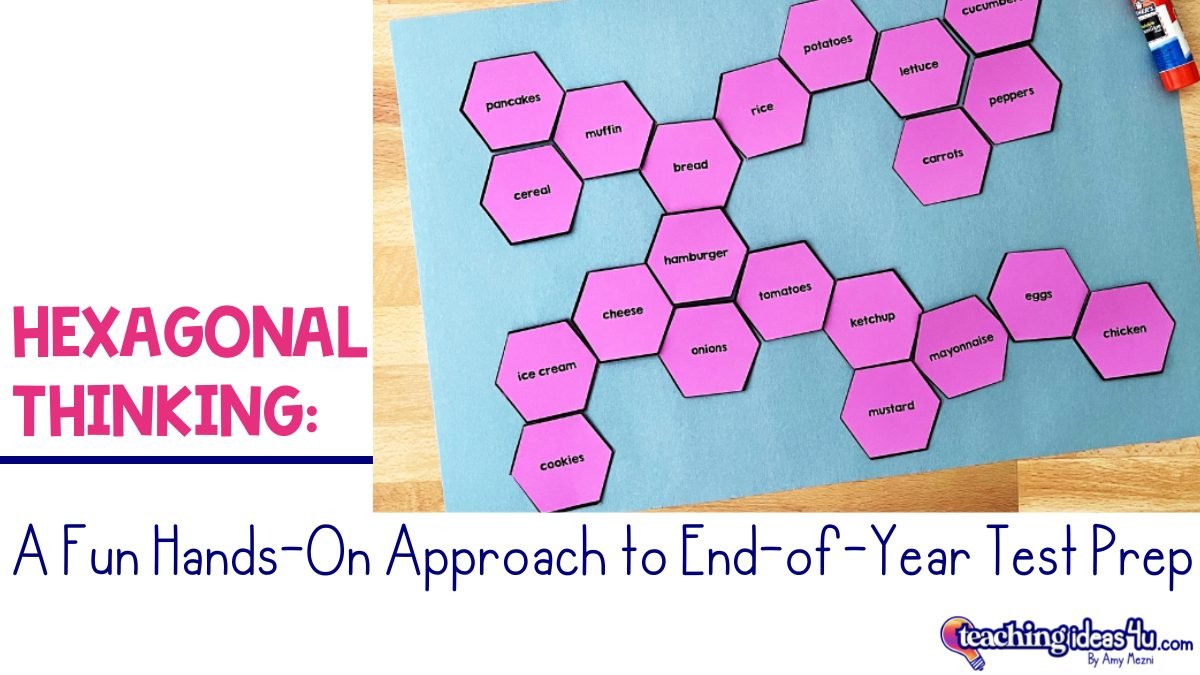Hexagonal Thinking: A Fun Hands-On Approach to End-of-Year Test Prep
Reviewing for end-of-the-year exams can be a challenge. There is a lot of content to cover in a short amount of time. Students who were disengaged throughout the year aren’t likely to suddenly change, so the review often doesn’t reach the students who need it the most.
But test prep can be hard even for your most engaged students. A long list of review topics and questions can be overwhelming. And boring. Seriously. I don’t enjoy completing a multiple-page worksheet, do you?
And that’s the problem - if your test prep doesn’t get kids mentally involved, then it isn’t going to be effective. So how can teachers make their end-of-course reviews better?
Every student is unique and has different learning needs, but using active learning with the following traits are more likely to get kids interested and involved:
Movement - Sitting is hard. Think about the last sit-down professional development you attended. How often were the attendees off task? Incorporating movement into your review will help prevent boredom and keep students on-task. It also helps high-energy students focus, as they don’t need to use their energy to try to sit still and can channel it towards learning.
Interaction - Let’s face it: some students are just very social. Providing a positive way to channel that energy is far better than fighting with kids to be quiet. Allowing students to work together also supports learning, as they can get help with concepts they didn’t understand or forgot.
Low-Risk - Test review should be just that - review, not a grade or a test. If students know they can ask for help from another student or the teacher, they are less likely to “cheat” and actually do the work. By making the review low-risk, teachers can entice all students to at least try - which is far better than just copying the answers from another student.
Hexagonal Thinking Activities
Although there are many review activities that have all of these traits, one of my favorites that you might not have considered is Hexagonal Thinking. If you haven’t heard of hexagonal thinking, it’s a hands-on activity in which students interact with terms on hexagons to create maps by determining connections between the concepts. For more information about these activities, see my blog post “Getting Started with Hexagonal Thinking.”
Hexagonal Thinking has many benefits, including:
It uses higher-order thinking skills.
It is also low-prep.
It is flexible in how it can be used. Simply put key terms on hexagons and give them to students.
The maps can be made alone, with a partner, or in a small group.
There isn’t one right answer - students can continue to find connections and move the pieces around until they are satisfied with their map.
Teachers can also use hexagonal thinking in a variety of ways, such as:
To review a specific chapter/concept.
To compare ideas. Ex. two novels, two civilizations, two wars, etc,
To focus on specific information, such as only including events or famous leaders. In science, teachers might want students to compare rocks or chemical elements.
As a year-end activity, Hexagonal Thinking activities usually focus on the major concepts taught, so students would review key points. If students don't remember some, they can use their notes or textbook to find the information.
To save time and resources, teachers can laminate the pieces so they are reusable. Instead of having students glue the pieces to make a map, they could take a quick photo of their finished product. These photos could be projected or shared digitally so the class could discuss and compare the maps. Students could quickly explain why they connected some of their terms, and the class could compare how each group connected a particular term to others.
Ready to try Hexagonal Thinking?
To save you time, I have world history hexagonal thinking activities already made! Each topic includes both printable and digital versions, and the hexagons are editable so you can change the activities to fit your students’ needs. You can find these hexagonal thinking activities in my TPT store.
For more information on the benefits of active learning, please see:
CMU News. (2021, October 14). Active learning in classrooms leads to increased student achievement. Carnegie Mellon University. https://www.cmu.edu/news/stories/archives/2021/october/active-learning.html
Daniels, N. (2006). The impact of hands-on activities on student achievement in the high school science classroom (Master's thesis, Old Dominion University). Retrieved from https://digitalcommons.odu.edu/cgi/viewcontent.cgi?article=1109&context=ots_masters_projects

